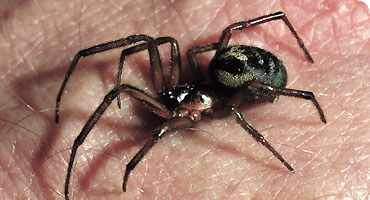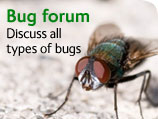False widow spider, Steatoda nobilis
Body size
Female to 15mm; male to 10mm.
Appearance
Rotund, brown with pale markings. Apart from colour, differs from Latrodectus (black widow spiders) in having teeth on the chelicerae. Only female (photo) bites.
Habitat, range and season
Buildings and fences. Originally a native of the Canary Islands and Madeira; now established in the southern and eastern coastal region of England and inland in Surrey.
First recorded in the UK
1879. Not considered to be established until the 1980's (Jones, 1987).
Bite reports
The bite itself is not usually felt but, within a short space of time, a local burning sensation is followed by radiating pain ('far more severe than a bee or wasp sting', Warrell et al., 1991).
'Sudden onset of intense pain, radiating across thigh. Lasted 20 minutes with some swelling and a developing weal.'
'Bitten on left hand; within 3/4 hour developed swelling of palm including thumb and fingers with tingling in all fingers. Swelling on left side of face with tingling over face. Two small puncture wounds in the region of the swelling, surrounded by local erythema with small bluish tinge a few hours later.'
'Bite on arm (area red) immediate pain. Spread to chest - still stiff 48 hours later.'
'Burning sensation on the right side of ribs. Increased in intensity, like being scalded, stabbing pains spread first to armpit then down right arm. Also flu-like symptoms, aches, sweats, fatigue, perspiring, cold and shaky, sick and giddy (all in first 10 minutes). Face and right arm went purplish and slightly puffy. Bite mark raised with red area c. 5 or 6cm. After 1 hour, responded to Piriton but felt unwell for 3 days.'
'Bitten on the shoulder. Initially the top of my arm ached, then felt itchy. Ten minutes later my armpit became numb. The skin was hot and sticky and looked wrinkled. The tenderness and itchiness lasted for some days' (later said to be infected).
Frequency of bites
Increasing as the species spreads in the south and east of England.


